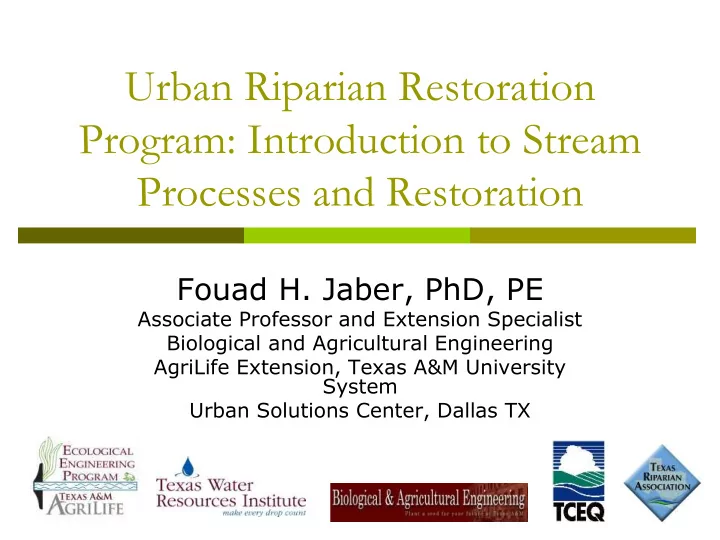

Urban Riparian Restoration Program: Introduction to Stream Processes and Restoration Fouad H. Jaber, PhD, PE Associate Professor and Extension Specialist Biological and Agricultural Engineering AgriLife Extension, Texas A&M University System Urban Solutions Center, Dallas TX
Outline Hydrologic cycle 1. Introduction to stream morphology 2. Bankfull Discharge 1. Stability 2. Channel measurements 3. Stream Classification 3. Stream Instability 4. Stream Restoration 5. Stabilization structures 6. Vegetation 7. Monitoring and evaluation 8.
Hydrologic Cycle
Stream Function Transporting water and sediments Habitat to aquatic organisms Trees and shrubs on banks provide food source and regulate temperatures Channel features such as pools, riffles and glides provide diversity Natural design important to maintain these features
Bankfull Discharge Most important process defining channel Effective (or dominant) discharge Transports majority of sediment load in stream Considered the insipient point of flooding
Natural Channel Stability
Channel Dimension and Characteristics It is the cross section of stream at bankfull measured at a stable riffle in stream Width of stream increases as you go downstream In arid regions, streams are wider due to lack of vegetation and erosion The mean depth of stream varies within stream depending on channel slope and riffle/pool spacing
Meander Geometry
Channel features Sequences of riffles and pools Riffles: larger rock particles, shallower, and steeper Pools: flat surfaces, deep Run: between riffles and pools Glide: between pools and riffles
Natural Stream Restoration Utilizes reference reach Includes bankfull and floodplain areas Restoration should result in water and sediment movement without degradation or aggradation Improves habitat and promotes diversity Promotes riparian vegetation
Stream Assessment Determine watershed drainage area (GIS) Determine land use (map or survey) Determine bankfull (field observation) Determine channel dimension (survey) Determine stream pattern: sinuosity, radius of curvature, belt width and meander wavelength (1:24000 maps) Channel profile
Stream Assessment Substrate Analysis Estimate bankfull discharge and velocity (Manning’s equation) Assess riparian condition: topography of floodplain, constraints in urban settings, soil fertility, plant inventory
Level I Assesment
Level II: Key terms Entrenchment ratio: Width of the flood prone area/bankfull surface width Sinuosity: Stream Length/ Valley Length
Level III Watershed scale instability Channelization Development Local (reach) instability Outside bank of meander bend Channel constrictions Channel stability assessment Channel evolution Streambank erosion
Watershed Scale Instability
Local Scale: Outside Bend Erosion
Local Scale: Channel Constrictions
Channel Evolution
Channel Evolution
Degradation and Widening
Channel Evolution
Stream Evolution: F4 Channel
Bank Erodibility Factors
Erodibility
Stream Restoration Options I- Establish bankfull at historical floodplain elevation: E, C
II- Create new floodplain at present elevation: E, C
Priority 2 Before After
III- Widen floodplain B, Bc
Priority 3 Before After
IV- Stabilize Existing Streambanks in place Use in-stream structures Riprap? Gabions? Concrete? Bioengineering Study upstream and downstream impacts
Stream Stabilization?
Structures: Root Wad
Structures: J-HookVanes
Structures: Cross-Vane
Structures: W-weir
Stream Crossings
Vegetation: Assessments are Needed Prior to Construction Determine if existing vegetation is a good template for revegetation Discover problematic issues to plan for before construction Identify special features to enhance or protect Gather ecological data for restoration planning
Plant inventory • Use local guides • Check for natural resource publications • Contact plant professionals
Soils Nutrients Compactedness Composition Plans for tilling, mulching, liming
Problematic and Invasive Plants http://www.texasinvasives.org/invasives_database/
Vegetation Salvage on-site vegetation Live staking (2-4 feet apart) Bare-root planting Container plant material Permanent seeding
Do Not Mow Streambanks Promotes bank stability Flood flow reduction Water quality Reduction of mosquito habitat Wildlife habitat
Evaluation and Monitoring Morphology Photo documentation Vegetation Bank stability Shading and temperature Fish and invertebrate data
Links and Resources USDA Stream Restoration Design: https://directives.sc.egov.usda.gov/viewerFS.aspx?id=3491 Wildland Hydrology Resources: https://wildlandhydrology.com/resources/ NC State University Dept. of Biological and Agricultural Engineering Extension Publications: https://www.bae.ncsu.edu/extension/extension-publications/ Ohio Department of Natural Resources: http://www.dnr.state.oh.us/tabid/4159/default.aspx Texas Stream Team at The Meadows Center for Water and the Environment: http://txstreamteam.rivers.txstate.edu/ Invasives Database: http://www.texasinvasives.org/invasives_database/ Texas A&M AgriLife Ecological Engineering Group: www.facebook.com/agrilifeecoeng/ The Dallas Center’s Urban Ecological Engineering Program: http://dallas.tamu.edu/extension/engineering/
Fouad H. Jaber, PhD, PE Associate Professor and Extension Specialist Biological and Agricultural Engineering Texas A&M AgriLife Extension Dallas Research and Extension Center f-jaber@tamu.edu 972-952-9672 www.facebook.com/agrilifeeco eng/
Recommend
More recommend